Related Research Articles

Raúl Modesto Castro Ruz is a Cuban retired politician and general who served as the first secretary of the Communist Party of Cuba, the most senior position in the one-party communist state, from 2011 to 2021, and President of Cuba between 2008 and 2018, succeeding his brother Fidel Castro.
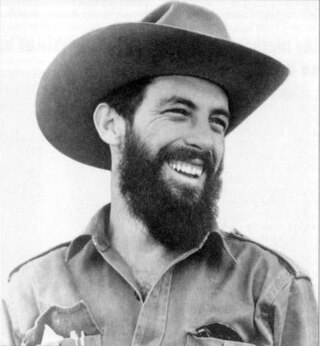
Camilo Cienfuegos Gorriarán was a Cuban revolutionary. One of the major figures of the Cuban Revolution, he was considered second only to Fidel Castro among the revolutionary leadership.
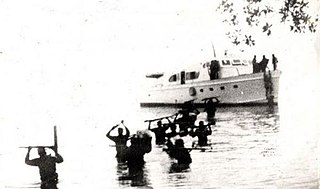
Granma is a yacht that was used to transport 82 fighters of the Cuban Revolution from Mexico to Cuba in November 1956 to overthrow the regime of Fulgencio Batista. The 60-foot diesel-powered vessel was built in 1943 by Wheeler Shipbuilding of Brooklyn, New York, as a light armored target practice boat, US Navy C-1994, and modified postwar to accommodate 12 people. "Granma", in English, is an affectionate term for a grandmother; the yacht is said to have been named for the previous owner's grandmother.

Alberto Díaz Gutiérrez, better known as Alberto Korda or simply Korda, was a Cuban photographer, remembered for his famous image Guerrillero Heroico of Argentine Marxist revolutionary Che Guevara.

Celia Sánchez Manduley was a Cuban revolutionary, politician, researcher and archivist. She was a key member of the Cuban Revolution and a close colleague of Fidel Castro.

Aleida March Torres is a Cuban revolutionary who was Ernesto "Che" Guevara's second wife, and a member of Fidel Castro's Cuban army.
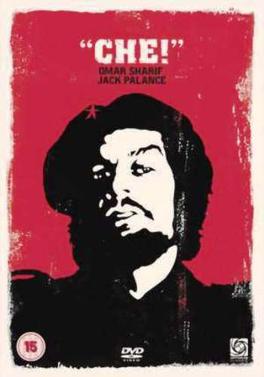
Che! is a 1969 American biographical film directed by Richard Fleischer and starring Omar Sharif as Marxist revolutionary Ernesto "Che" Guevara. It follows Guevara from when he first landed in Cuba in 1956 to his death in Bolivia in 1967, although the film does not portray the formative pre-Cuban revolution sections of Che's life as described in the autobiographical book The Motorcycle Diaries (1993).

Jon Lee Anderson is an American biographer, author, investigative reporter, war correspondent, and staff writer for The New Yorker, reporting from war zones such as Afghanistan, Iraq, Uganda, Palestine, El Salvador, Ireland, Lebanon, Iran, and throughout the Middle East as well as during Hurricane Katrina rescue efforts with K38 Water Safety as documented in the New Yorker article Leaving Desire. Anderson has also written for The New York Times, Harper's, Life, and The Nation. Anderson has profiled political leaders such as Hugo Chávez, Fidel Castro, Che Guevara, and Augusto Pinochet.
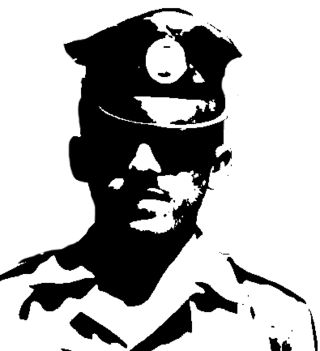
Mario Terán Salazar was a Bolivian Army warrant officer who executed Che Guevara as a young sergeant in 1967. Guevara, a Marxist revolutionary from Argentina, had played a major role in the Cuban Revolution, in which the 26th of July Movement, led by Fidel Castro, ousted U.S.-backed dictator Fulgencio Batista and replaced his government with a revolutionary socialist state.
The Cuban Revolution was the overthrow of Fulgencio Batista's regime by the 26th of July Movement and the establishment of a new Cuban government led by Fidel Castro in 1959.

Ernesto "Che" Guevara was an Argentine Marxist revolutionary, physician, author, guerrilla leader, diplomat, and military theorist. A major figure of the Cuban Revolution, his stylized visage has become a ubiquitous countercultural symbol of rebellion and global insignia in popular culture.

Orlando Borrego is a Cuban economist, writer and former guerrilla who worked with Che Guevara during the Cuban Revolution.
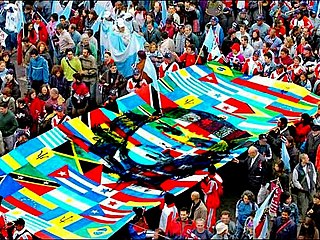
The legacy of Argentine Marxist revolutionary Che Guevara is constantly evolving in the collective imagination. As a symbol of counterculture worldwide, Guevara is one of the most recognizable and influential revolutionary figures of the twentieth century. However, during his life, and even more since his death, Che has elicited controversy and wildly divergent opinions on his personal character and actions. He has been both revered and reviled, being characterized as everything from a heroic defender of the poor, to a cold-hearted executioner.
Ernesto "Che" Guevara, was an Argentine Marxist revolutionary, politician, author, intellectual, physician, military theorist, and guerrilla leader. His life, legacy, and ideas have attracted a great deal of interest from historians, artists, film makers, musicians, and biographers. In reference to the abundance of material, Nobel Prize–winning author Gabriel García Márquez has declared that "it would take a thousand years and a million pages to write Che's biography."

Guerrillero Heroico is an iconic photograph of Marxist revolutionary Che Guevara taken by Alberto Korda. It was captured on March 5, 1960, in Havana, Cuba, at a memorial service for victims of the La Coubre explosion. By the end of the 1960s, the image, in conjunction with Guevara's subsequent actions and eventual execution, helped solidify the leader as a cultural icon. Korda has said that at the moment he shot the picture, he was drawn to Guevara's facial expression, which showed "absolute implacability" as well as anger and pain. Years later, Korda would say that the photograph showed Che's firm and stoic character. Guevara was 31 years old at the time the photograph was taken.
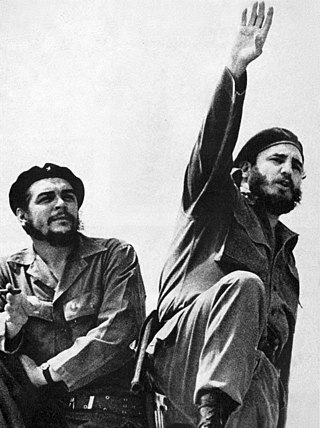
The consolidation of the Cuban Revolution is a period in Cuban history typically defined as starting in the aftermath of the revolution in 1959 and ending in the first congress of the Communist Party of Cuba 1975, which signified the final political solidification of the Cuban revolutionaries' new government. The period encompasses early domestic reforms, human rights violations continuing under the new regime, growing international tensions, and politically climaxed with the failure of the 1970 sugar harvest.
The attack on El Uvero was an armed confrontation between the 26th of July Movement and the Cuban military on May 28, 1957, part of the Cuban Revolution. It was the first major confrontation between the 26th of July Movement, led by Fidel Castro, and the Cuban military, led by Fulgencio Batista, since the latter settled in Sierra Maestra.
Eduardo "Lalo" Sardiñas was a combatant of Cuban Revolution, and a member of the 26th of July Movement, led by Fidel Castro during 1958 and 1959.

The Monumento Encuentro refers to two bronze statues seated on a bench in Colonia Tabacalera, Cuauhtémoc, Mexico City. Otherwise known as the bench of Fidel Castro and Che Guevara and the statues of Fidel Castro and Che Guevara, the artwork features sitting statues of Fidel Castro and Che Guevara, major figures of the Cuban Revolution (1953–1959). The monument references the first time both met in 1955 in Tabacalera.
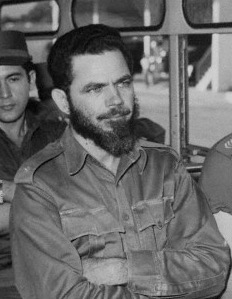
The Huber Matos affair was a political scandal in Cuba when on October 20, 1959, army commander Huber Matos resigned and accused Fidel Castro of "burying the revolution". Fifteen of Matos' officers resigned with him. Immediately after the resignation, Castro critiqued Matos and accused him of disloyalty, then sent Camilo Cienfuegos to arrest Matos and his accompanying officers. Matos and the officers were taken to Havana and imprisoned in La Cabaña. Cuban communists later claimed Matos was helping plan a counter-revolution organized by the American Central Intelligence Agency and other Castro opponents, an operation that became the Bay of Pigs Invasion.
References
- ↑ Fontova, Humberto (2007). Exposing the Real Che Guevara: And the Useful Idiots Who Idolize Him. Sentinel HC. p. xi. ISBN 1-59523-027-0.
- ↑ Chapman, Robert D. "Remembered by the Winds of Revolution". International Journal of Intelligence and CounterIntelligence . 22 (2): 352–6. doi:10.1080/08850600802698333.
- ↑ Chapman, Robert D. "Righting Cuban History". International Journal of Intelligence and CounterIntelligence . 27 (2): 421–4. doi:10.1080/08850607.2014.872542.
- 1 2 3 4 Potts, Rolf (January 27, 2009). "Che: The Ronald McDonald of Revolution". World Hum .
- ↑ Alex Singleton bio page Archived 2011-09-27 at the Wayback Machine at the Institute for Humane Studies
- 1 2 Singleton, Alex (March 6, 2008). "Alex Singleton on the two Che Guevaras". Social Affairs Unit .
- 1 2 3 Casey, Michael (2009). Che's afterlife: the legacy of an image. New York: Vintage Books. pp. 249–50. ISBN 0-307-27930-8.
- ↑ Fontova, Humberto (October 8, 2009). "Che Guevara: Assassin, Coward, Imbecile". Canada Free Press.